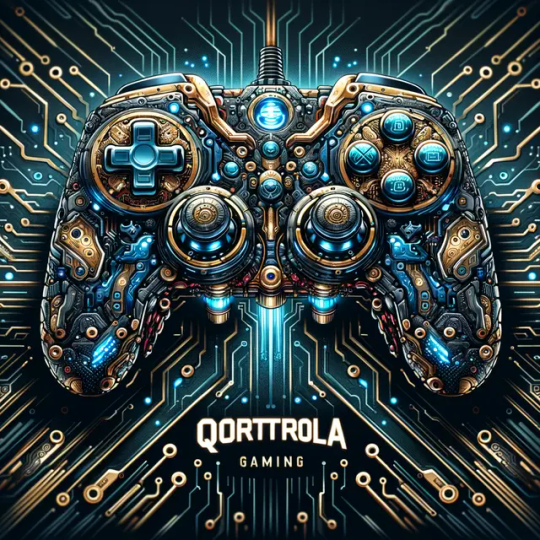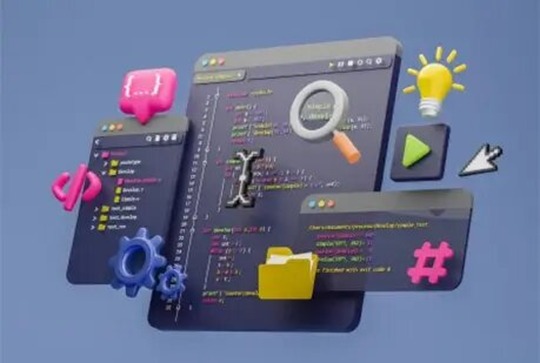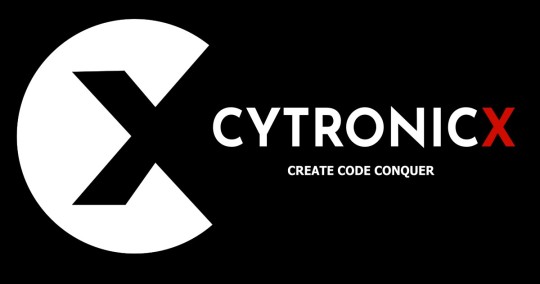#Hardware and IoT
Explore tagged Tumblr posts
Text

The Future of Decentralized Gaming has arrived, Don't believe me? Then dive into the essence of what I envision for this revolutionary Idea. Help bring it into fruition by reading, analyzing, and understanding the conceptual framework I've created. The beginning of the future is now, Read My blogs below, where I bridge the current Web2 centralized legacy gaming systems into a Decentralized Web3 ecosystem, Enabling Gamers to be incentivized, monetized, and recognized for their gaming data-which only will be in their Control.
Welcome to QorTrola Gaming, where #Web3, #Blockchain, #Crypto, #Decentralization, #DePIN, #Data, #Gaming, #BlockchainGaming, #Monetization, #Hardware and #IoT all combine to create a dedicated system for gamers to control and sell their gaming data as they please.
Check it out 👇
https://qortrolagaming.wordpress.com/
#Web3#Blockchain#Crypto#Decentralization#DePIN#Data#Gaming#BlockchainGaming#Monetization#Hardware and IoT
12 notes
·
View notes
Text

OPT4048 - a "tri-stimulus" light sensor 🔴🟢🔵
We were chatting in the forums with someone when the OPT4048 (https://www.digikey.com/en/products/detail/texas-instruments/OPT4048DTSR/21298553) came up. It's an interesting light sensor that does color sensing but with diodes matched to the CIE XYZ color space. This would make them particularly good for color-light tuning. We made a cute breakout for this board. Fun fact: it's 3.3V power but 5V logic friendly.
#opt4048#lightsensor#colortracking#tristimulus#ciexyz#colorsensing#texasinstruments#electronics#sensor#tech#hardware#maker#diy#engineering#embedded#iot#innovation#breakoutboard#3dprinting#automation#led#rgb#technology#smartlighting#devboard#optoelectronics#programming#hardwarehacking#electronicsprojects#5vlogic
85 notes
·
View notes
Text
theredditblog
Iam paulalice working for theredditblog as PR consultant.With more than 6 year’s experience in PR and Digital Industry,helping teams to achieve goals by streamlining the process.
#technology#web#IT#software#hardware#cybersecurity#artificial intelligence#AI#Internet of Things#IoT#tech trends#how-to guides#tutorials#gadgets#gadget reviews#tech news#innovation#digital marketing#telecommunications#science#tech blog#tech education#freelance writing#guest post#tech community#emerging technology#latest technology#tech insights#tech articles#tech enthusiasts
3 notes
·
View notes
Text
Fine—Until It Isn’t: A case for nearshore IoT

IoT thrives on iteration. Whether it’s refining enclosures for IP67 protection, modifying mounting points, or adding new sensors, the ability to adapt in real-time is the crux. Nearshore manufacturing isn’t about supply chain efficiency—it’s about retaining process control, reducing inherent risks, keeping operations agile and modular. It is real-time cost/benefit analytics played out on a map of the world using ships as markers and weather patterns as dice.
#Benefit#Configuration#Cost#Design#Flexibility#Hardware#IoT#Nearshoring#Shipping#Supply Chain#Tech Support
1 note
·
View note
Text

IoT Development Services by MeshTek: Transforming Connectivity with Advanced Technology:-
This vibrant 3D image symbolizes the essence of MeshTek's IoT development services. It showcases the integration of programming, innovation, and smart technologies that power IoT solutions. With a focus on seamless coding, real-time data processing, and efficient system design, MeshTek enables industries to create scalable and secure IoT networks for smarter, more connected operations.
#iot platform#iotsolutions#iot development services#technology#smartautomation#digital art#hardware#IoTDevelopmentServices#MeshTek#IoTSolutions#SmartTechnology#IoTProgramming#TechInnovation#ConnectedSystems#IoTInfrastructure#IoTApplications#IoTDesign
1 note
·
View note
Text

#iot#iot applications#iot development services#iot technology#iot app development#iot hardware security#iotdevices#iot development company#iotecosystem#iotsolutions
2 notes
·
View notes
Text
1 note
·
View note
Text
Boost Device Performance with Professional Firmware Testing at GQAT Tech
What is Firmware Testing & Why It’s Crucial for Smart Devices
In today's connected world, everything you use from your smartwatch to your smart TV runs on firmware; firmware is low-level software that operates hardware. So what happens when the firmware does not perform as it should? Devices crash, user experience drops, and businesses suffer—this is why firmware testing has become such a significant component of the quality assurance (QA) process.
At GQAT Tech, we perform firmware testing with intelligence using a combination of real hardware environments and automation to verify that every device operates exactly as intended. In this article, we will explore firmware testing, why it matters, and how GQAT Tech empowers you to deliver bug-free, top-performing smart products.
What is Firmware?
Firmware is a class of software that is permanently burned into a hardware item to complete the basic function and potentially further functions of that hardware item.
You’ll find firmware in:
Smartphones
IoT devices
Printers
Wearables
Routers
Smart home appliances
Firmware is unlike software in that it is not intended for frequent updates. Because of that, if there is a bug or unsafe code in the firmware, it may impact the firmware's intent or may compromise the entire device.
What is Firmware Testing?
Firmware testing is the validation and verification to check that the firmware behaves correctly when interacting with hardware and the other components in the system.
The key areas of testing firmware will include:
Functionality – Does the firmware do what it is intended to do?
Stability – Does it crash?
Performance – Is it efficient? Is it quick?
Security – Is it safe? Does it protect itself from unauthorized use or firmware-level attacks?
Testing firmware is more complicated than testing a software product due to the integration of hardware and software, so it's where GQAT Tech can provide its value here.
Why Firmware Testing is Important
Here’s why skipping firmware testing can lead to serious problems:
Device Failures – Bugs in firmware can crash your entire device.
Security Risks – Weak firmware can open doors to hackers.
Unstable Performance – Devices may freeze, restart, or act unexpectedly.
Poor User Experience – Customers won’t tolerate devices that don’t work properly.
Costly Product Recalls – Fixing bugs after launch can cost millions.
With firmware embedded in critical devices, testing before release is not optional—it’s necessary.
Why GQAT Tech?
Full-Service QA Team: Specialists in firmware and embedded testing.
Testing on Real Hardware: Hardware testing—not just simulators.
Custom Test Plans: Plans tailored to the specifics of your hardware, product goals, and release schedule.
Detailed Reporting: Bug reporting and test case coverage are clear and easy to understand.
Time-to-Market Speed: Find and fix firmware bugs earlier in the development cycle.
GQAT Tech will not only test your product, but it provide the assurance of reliability, scalability, and safety.
Conclusion
In a digital world, where the devices must "just work," firmware quality is critically important. Whether you're developing smart home, wearable, or industrial IoT devices, validating firmware will give you confidence that your product will deliver a zero-fail experience.
💬 Are you ready to approach firmware testing with confidence?
👉 Explore Firmware Testing Services at GQAT Tech
#Firmware Testing#Embedded Software Testing#Hardware Testing#IoT Device Testing#Quality Assurance#Low-Level Software Testing#Device-Level Testing#Embedded QA#Hardware Compatibility#Regression Testing#Automated Firmware Testing#GQAT Tech Testing Services#Tech QA#Software-Hardware Integration#Product Validation Testing
0 notes
Text
#custom ai model development#mobile app development#ai-driven hardware development#end-to-end product development#best sourcing specialists in india#principles of ui ux design#manufacturing support#iot embedded systems
0 notes
Text
AI-driven drone from University of Klagenfurt uses IDS uEye camera for real-time, object-relative navigation—enabling safer, more efficient, and precise inspections. High-voltage power lines. Electricity distribution station. high voltage electric transmission tower. Distribution electric substation with power lines and transformers. The inspection of critical infrastructures such as energy plants, bridges or industrial complexes is essential to ensure their safety, reliability and long-term functionality. Traditional inspection methods always require the use of people in areas that are difficult to access or risky. Autonomous mobile robots offer great potential for making inspections more efficient, safer and more accurate. Uncrewed aerial vehicles (UAVs) such as drones in particular have become established as promising platforms, as they can be used flexibly and can even reach areas that are difficult to access from the air. One of the biggest challenges here is to navigate the drone precisely relative to the objects to be inspected in order to reliably capture high-resolution image data or other sensor data. A research group at the University of Klagenfurt has designed a real-time capable drone based on object-relative navigation using artificial intelligence. Also on board: a USB3 Vision industrial camera from the uEye LE family from IDS Imaging Development Systems GmbH. As part of the research project, which was funded by the Austrian Federal Ministry for Climate Action, Environment, Energy, Mobility, Innovation and Technology (BMK), the drone must autonomously recognise what is a power pole and what is an insulator on the power pole. It will fly around the insulator at a distance of three meters and take pictures. "Precise localisation is important such that the camera recordings can also be compared across multiple inspection flights," explains Thomas Georg Jantos, PhD student and member of the Control of Networked Systems research group at the University of Klagenfurt. The prerequisite for this is that object-relative navigation must be able to extract so-called semantic information about the objects in question from the raw sensory data captured by the camera. Semantic information makes raw data, in this case the camera images, "understandable" and makes it possible not only to capture the environment, but also to correctly identify and localise relevant objects. In this case, this means that an image pixel is not only understood as an independent colour value (e.g. RGB value), but as part of an object, e.g. an isolator. In contrast to classic GNNS (Global Navigation Satellite System), this approach not only provides a position in space, but also a precise relative position and orientation with respect to the object to be inspected (e.g. "Drone is located 1.5m to the left of the upper insulator"). The key requirement is that image processing and data interpretation must be latency-free so that the drone can adapt its navigation and interaction to the specific conditions and requirements of the inspection task in real time. Thomas Jantos with the inspection drone - Photo: aau/Müller Semantic information through intelligent image processing Object recognition, object classification and object pose estimation are performed using artificial intelligence in image processing. "In contrast to GNSS-based inspection approaches using drones, our AI with its semantic information enables the inspection of the infrastructure to be inspected from certain reproducible viewpoints," explains Thomas Jantos. "In addition, the chosen approach does not suffer from the usual GNSS problems such as multi-pathing and shadowing caused by large infrastructures or valleys, which can lead to signal degradation and thus to safety risks." A USB3 uEye LE serves as the quadcopter's navigation camera How much AI fits into a small quadcopter? The hardware setup consists of a TWINs Science Copter platform equipped with a Pixhawk
PX4 autopilot, an NVIDIA Jetson Orin AGX 64GB DevKit as on-board computer and a USB3 Vision industrial camera from IDS. "The challenge is to get the artificial intelligence onto the small helicopters. The computers on the drone are still too slow compared to the computers used to train the AI. With the first successful tests, this is still the subject of current research," says Thomas Jantos, describing the problem of further optimising the high-performance AI model for use on the on-board computer. The camera, on the other hand, delivers perfect basic data straight away, as the tests in the university's own drone hall show. When selecting a suitable camera model, it was not just a question of meeting the requirements in terms of speed, size, protection class and, last but not least, price. "The camera's capabilities are essential for the inspection system's innovative AI-based navigation algorithm," says Thomas Jantos. He opted for the U3-3276LE C-HQ model, a space-saving and cost-effective project camera from the uEye LE family. The integrated Sony Pregius IMX265 sensor is probably the best CMOS image sensor in the 3 MP class and enables a resolution of 3.19 megapixels (2064 x 1544 px) with a frame rate of up to 58.0 fps. The integrated 1/1.8" global shutter, which does not produce any 'distorted' images at these short exposure times compared to a rolling shutter, is decisive for the performance of the sensor. "To ensure a safe and robust inspection flight, high image quality and frame rates are essential," Thomas Jantos emphasises. As a navigation camera, the uEye LE provides the embedded AI with the comprehensive image data that the on-board computer needs to calculate the relative position and orientation with respect to the object to be inspected. Based on this information, the drone is able to correct its pose in real time. The IDS camera is connected to the on-board computer via a USB3 interface. "With the help of the IDS peak SDK, we can integrate the camera and its functionalities very easily into the ROS (Robot Operating System) and thus into our drone," explains Thomas Jantos. IDS peak also enables efficient raw image processing and simple adjustment of recording parameters such as auto exposure, auto white Balancing, auto gain and image downsampling. To ensure a high level of autonomy, control, mission management, safety monitoring and data recording, the researchers use the source-available CNS Flight Stack on the on-board computer. The CNS Flight Stack includes software modules for navigation, sensor fusion and control algorithms and enables the autonomous execution of reproducible and customisable missions. "The modularity of the CNS Flight Stack and the ROS interfaces enable us to seamlessly integrate our sensors and the AI-based 'state estimator' for position detection into the entire stack and thus realise autonomous UAV flights. The functionality of our approach is being analysed and developed using the example of an inspection flight around a power pole in the drone hall at the University of Klagenfurt," explains Thomas Jantos. Visualisation of the flight path of an inspection flight around an electricity pole model with three insulators in the research laboratory at the University of Klagenfurt Precise, autonomous alignment through sensor fusion The high-frequency control signals for the drone are generated by the IMU (Inertial Measurement Unit). Sensor fusion with camera data, LIDAR or GNSS (Global Navigation Satellite System) enables real-time navigation and stabilisation of the drone - for example for position corrections or precise alignment with inspection objects. For the Klagenfurt drone, the IMU of the PX4 is used as a dynamic model in an EKF (Extended Kalman Filter). The EKF estimates where the drone should be now based on the last known position, speed and attitude. New data (e.g. from IMU, GNSS or camera) is then recorded at up to 200 Hz and incorprated into the state estimation process.
The camera captures raw images at 50 fps and an image size of 1280 x 960px. "This is the maximum frame rate that we can achieve with our AI model on the drone's onboard computer," explains Thomas Jantos. When the camera is started, an automatic white balance and gain adjustment are carried out once, while the automatic exposure control remains switched off. The EKF compares the prediction and measurement and corrects the estimate accordingly. This ensures that the drone remains stable and can maintain its position autonomously with high precision. Electricity pole with insulators in the drone hall at the University of Klagenfurt is used for test flights Outlook "With regard to research in the field of mobile robots, industrial cameras are necessary for a variety of applications and algorithms. It is important that these cameras are robust, compact, lightweight, fast and have a high resolution. On-device pre-processing (e.g. binning) is also very important, as it saves valuable computing time and resources on the mobile robot," emphasises Thomas Jantos. With corresponding features, IDS cameras are helping to set a new standard in the autonomous inspection of critical infrastructures in this promising research approach, which significantly increases safety, efficiency and data quality. The Control of Networked Systems (CNS) research group is part of the Institute for Intelligent System Technologies. It is involved in teaching in the English-language Bachelor's and Master's programs "Robotics and AI" and "Information and Communications Engineering (ICE)" at the University of Klagenfurt. The group’s research focuses on control engineering, state estimation, path and motion planning, modeling of dynamic systems, numerical simulations and the automation of mobile robots in a swarm: More information uEye LE - the cost-effective, space-saving project camera Model used:USB3 Vision Industriekamera U3-3276LE Rev.1.2 Camera family: uEye LE Image rights: Alpen-Adria-Universität (aau) Klagenfurt © 2025 IDS Imaging Development Systems GmbH
#AI#Development#EducationStudies#English#General#Hardware#IoT#UAVDrones#Video#Camera#Drone#IDS#IDSImagingDevelopmentSystems#IDSpeakSDK#IDSuEye#ImageProcessing#ROS#UAV#UniversityKlagenfurt#USB3
0 notes
Text


#Web3#Blockchain#Crypto#Decentralization#DePIN#Data#Gaming#BlockchainGaming#Monetization#Hardware and IoT
0 notes
Text

Triple Matrix Bonnet Makes Big Bright Displays 🔴🟢🔵✨
With our latest work on getting HUB75 RGB matrices working on the Raspberry Pi 5
we can now create stunning LED displays. But what if we want more pixels? At some point, we max out the bandwidth of the RP1 chip, but we can still squeeze out additional performance by updating the PIO commands to output two or three matrix strings instead of just one.
Thus, the Triple Output RGB Matrix Bonnet you see here! We're using the classic Active-3 pinout
with a switch to select whether the 4th or 8th pin is connected to address E.
Since we expect large matrix grids drawing 10A+ of current, there's no onboard power management—the 5V supply should be connected separately through thick power wires. This board is for data only. If you aren't using port 3, the I2C remains available, so we've added a Stemma QT port for extra flexibility.
#leddisplay#raspberrypi5#rgbmatrix#adafruit#electronics#maker#tech#opensource#diy#hardware#innovation#lighting#embedded#creativecoding#coding#raspberrypi#matrixdisplay#ledmatrix#iot#hardwarehacking#piomatter#blinka#stemmaqt#hackerspace#engineering#prototyping#techgadgets#electronicprojects#powerfuldisplays#makersmovement
47 notes
·
View notes
Text
I know I've technically written software for it, which one could argue means I'm having an active role in supporting its continued existence, but holy FUCKING shit I hate the LaMetric TIME what a useless fucking hunk of overpriced shit.
You'd think making a bluetooth speaker function as a bluetooth speaker would be easy, or that a 200 hundred fucking dollars "smart" display would be able to do any data processing at all onboard without depending on an external server spoonfeeding it information in the exact format it wants, but, alas,
#(for the record I did not pay for it my roommate did and I've been trying to make it less useless bc like might as well yknow?)#(but I fucking hate this thing it's so bad at literally everything it set out to do)#(like omg fucking LET ME RUN CODE ON THE FUCKING DEVICE WHY THE FUCK WOULD YOU MAKE AN IOT DEVICE THAT DOESN'T DO JACK SHIT BY ITSELF)#(I SUCK AT HARDWARE BUT IF I HAD A 3D PRINTER IM 100% SURE I COULD MAKE SMTH MUCH BETTER FEATURED THAN THIS CRAP)#(NOT TO MENTION IT'LL BE A SHITTY RUBBERIZED PLASTIC PAPERWEIGHT WHEN LAMETRIC INEVITABLY GOES UNDER AND SHUTS DOWN THEIR SERVERS LIKE JFC)#deerbleats
0 notes
Text
Hardware: Mind is limitless, matter has constraints

Manufacturing is not a deployment script. Software is copied at scale; hardware is built at scale. Component shortages, supply chain bottlenecks and minor spec changes can derail entire projects if not accounted for from the start. And you can’t account for everything at the start. Project management is focused on cost, scope, quality and documentation, but maybe that elephant in the room is reality.
1 note
·
View note
Text

Next-Gen IoT Solutions for Effortless Connectivity and Control-MeshTek
Experience the future of IoT with our next-generation solutions designed for effortless connectivity and intelligent control. Featuring long-range Bluetooth mesh technology, real-time monitoring, and scalable architecture, our platform empowers you to manage devices seamlessly. With intuitive mobile apps and advanced analytics dashboards, you can monitor performance, optimize operations, and scale networks effortlessly.
#iot development services#iot platform#iotsolutions#digital art#technology#hardware#mobile application development
1 note
·
View note
Text
Nexus: The Dawn of IoT Consciousness – The Revolution Illuminating Big Data Chaos
#Advantech IoT#Aware World#Big Data#Big Data Chaos#Bosch IoT#Cisco IoT#Connected World#Contextual Awareness#Contextual Understanding#Continuous Improvement#Data Filtering#Distributed Intelligence#Edge AI#edge computing#Edge Data#Edge Intelligence#Edge Processing#HPE Edge#Intelligent Systems#Internet of Things#IoT#IoT Awareness#IoT Consciousness#IoT Ecosystem#IoT Hardware#IoT Networking#IoT Platform#Lean Efficiency#Nexus#Operational Optimization
0 notes